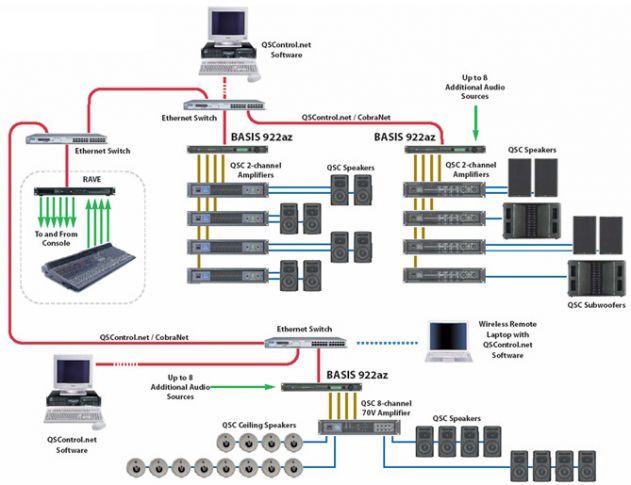Lesson Description

The diagram above illustrates a "typical" network audio system. Except
for the red network cabling and the Ethernet switches, it's not much
different than a standard, non-networked audio system. There are inputs
to the left and amplifiers and loudspeakers throughout the system. This
could be any sound system you've installed or designed; a church,
restaurant or club, a convention center, a portable touring rig, a
sports facility or a school. The scale of the system is really the only
difference. All we've done is used a network in place of individual
audio feed lines, and peppered BASIS products throughout the system.
Audio processing can take place in each BASIS device or the BASIS unit
can be used simply for signal routing and amplifier monitoring and
control. Other types of networked audio systems are designed to use a
centralized processor so that all the processing and audio is routed
through one main processor. This poses a potential problem in that if
that box fails you've lost the entire system - it's a single point of
failure. BASIS, on the other hand, is a distributed processing system.
Wherever you have a group of amps, such as four to eight amps, place a
BASIS to locally process the audio for those amps. You can monitor and
control that group of amps and loudspeaker loads simultaneously. Audio
is passed to and from the amp group zones via the network using CobraNet
as the digital audio network. No one single BASIS has to do all of the
processing of the system, it is shared among all the BASIS devices. In
the unlikely event of loss of power to, or failure of, one zone or
network segment, the remainder of the system stays up and online,
allowing the system to "limp along" while troubleshooting and repairs
are carried out for the offline zone.
A QSControl.net system
can have one or more computers on the network, controlling all or part
of the system. Laptops or tablet PCs can also access, control, and
monitor any or all of the system over a wireless network connection.

